-
Posts
148 -
Joined
-
Last visited
-
Days Won
6
Content Type
Profiles
Forums
Store
Gallery
Downloads
Calendar
C-130 Hercules News
Posts posted by casey
-
-

LITTLE ROCK AIR FORCE BASE, Ark. -- Aircraft maintenance units at Little Rock Air Force Base recently turned toward implementing Torque, a software suite of tools and applications, as part of an effort to streamline processes and efficiency to improve productivity across the units and installation.
In an effort to align with Air Force Chief of Staff Gen. Charles. Q. Brown Jr.’s Action Order Delta: Design Implementation, Torque was first introduced within one of 19th AMXS’s smaller sections, allowing users to see firsthand how the software could potentially replace their dated databases.
Designed and developed by Kessel Run, the U.S. Air Force’s product development and programming team, the 19th Aircraft Maintenance Squadron began beta testing the software in January 2021.
“We used our smallest shop as a testbed to assess what the capabilities were and how we could leverage it to our advantage,” said Master Sgt. Jose Piedra, 19th AMXS section chief. “Once we gained this understanding, we started onboarding all of our shops week by week.”
Piedra said the primary advantage of the Torque platform is the ability to pull and transfer data between various applications and integrate that information into a consolidated location, which is capable of updating in real-time due to the software’s modern technology.
Specific to LRAFB-based maintenance units, the upside to the new software is its enhanced personnel management function, which improved the ability to track appointments, manning, and qualifications of all maintainers within one system.
“It allows for synchronization of our entire team,” said Piedra. “Torque has many advantages including: allowing multiple people to login at the same time; access to full-time programmers that can add features; personal cellular device accessibility; and the data is stored on the cloud and is not dependent on government networks.”
Once the capabilities were clear and the 19th AMXS knew what they had, it was shared with mission partners across LRAFB.
“We linked up with 19th AMXS to see what the product looked like and sat in on some Zoom meetings with Kessel Run,” said Master Sgt. Nathan Horrocks, 314th AMXS section chief. “This familiarized us with the program and let us know what to expect. We have now been using the system for several months.”
Despite the advantages Torque provides TLR aircraft maintenance, Horrocks said funding beyond FY21 is not guaranteed and could lead to reverting back to their old systems.
“If Torque was no longer available we would have a couple of options,” Horrocks said. “We could pursue another application, which would cost more money, or revert back to our old systems, which took more time and was much less efficient.”
The advantages to using Torque is why Piedra and Horrocks want to see it stick around, because without it, they said mission efficiency suffers.
“Torque lowers the possibility of scheduling conflicts or overcommitting our people,” Piedra said. “With our old programs we would come into scheduling conflicts. Moreover, on some occasions the schedule wasn’t updated and we wouldn’t have the appropriate coverage. Torque allows us to all be on the same page and optimize mission effectiveness.”
View Original Article: Torque synchronizes TLR C-130J aircraft maintenance > Little Rock Air Force Base > Article Display
-

PETERSON SPACE FORCE BASE, Colo. (AFNS) --
The 302nd Airlift Wing has three C-130 Hercules aircraft flying sorties out of McClellan Air Tanker Base this year in Sacramento County, California, performing an aerial firefighting mission unique within the Air Force Reserve.Since first being activated July 20, the 302 AW has been working together with other military aircraft from Nevada Air National Guard’s 152nd AW, Wyoming ANG’s 153rd AW, and California ANG’s 146th AW to drop millions of gallons of fire retardant in support of fire suppression efforts in California.
On Aug. 25, all eight C-130 aerial firefighting aircraft were activated for the first time since 2012. The aircraft are equipped with a U.S. Forest Service Modular Airborne Firefighting System unit loaded in the cargo bay without requiring any structural modifications to the airframe, enabling crews to drop up to 3,000 gallons of fire retardant in less than 5 seconds over a quarter mile stretch of land.
As of Sept. 12, the combined effort of these units has resulted in the delivery of 23 million pounds of fire retardant through 925 drops over a variety of fires since ANG assistance was first requested June 26. This has been the second highest producing season in the 48-year history of MAFFS. The California Department of Forestry and Fire Protection, or CAL FIRE, the host unit at McClellan ATB, also broke personal records this year by mixing and delivering 6.5 million gallons of fire retardant supporting military and civilian aerial firefighting aircraft alike.
“Everything we do is to support the work accomplished by the crews on the ground,” said Lt. Col. Brad Ross, 302nd Operations Group commander. “With a few rare exceptions, the retardant drops cannot put out a fire on their own, but slow the fire and reinforce lines laid by the firefighters providing a better opportunity to contain the fire.”
Ross said firefighting efforts have been focused on the Dixie, Caldor, Antelope, River Complex, Monument, French and several other smaller fires. Each fire presents its own unique challenge, whether it’s variations in terrain, problems with visibility, or ensuring separation from other aircraft on larger fires. Even though there are well-established procedures preparing crews for these challenges, that doesn’t mean it’s easy.
“Flying MAFFS is the most tactical, challenging flying that we do outside of deployed combat zones,” said Master Sgt. Michael Davenport, 731st Airlift Squadron loadmaster. “Low-level flying in the mountains over ridges and through valleys for retardant drops 150-200 feet above ground level while considering weather and fire conditions requires the best, most experienced aircrews a squadron has to offer.”
Davenport said the most important part of MAFFS is maintaining situational awareness. Each crew member needs to be aware of everything happening around them while flying to and from fires. Everyone is listening to radio calls, watching airspeeds and altitudes, monitoring aircraft and MAFFS systems while communicating with one another every step of the way. Situational awareness and warding off tunnel vision is vital for flying in general, but significantly more important when flying over wildfires.
The number of drops on any given day depends on a wide variety of factors. During calm days with no breeze it’s possible for smoke to linger and greatly impact visibility during flight, limiting the ability of crews to drop. They also don’t fly before sunrise or after sunset because it adds another layer of risk to an already challenging mission. But, when conditions are right, it’s possible for one crew to perform 15 drops in a single day.
Everybody needs to be ready to go within minutes in case a launch order is called for, and crews are often on standby until sunset. Each drop involves a coordinated effort between aircrew, maintenance teams, CAL FIRE ground crew and the U.S. Forest Service to ensure the process goes as smoothly and safely as possible, from the moment the aircraft starts to the moment the fire retardant is discharged.
“All of us take a tremendous amount of pride from being a part of flying the MAFFS mission,” Davenport said. “Every year we see firsthand what kind of destruction wildfires can cause, so it’s an honor to be part of a larger effort to stop them and keep people safe.”
At one point during the season, all eight military aircraft were airborne at the same time working together to fight the Dixie fire on its eastern and western zones. Ross said it can be challenging maneuvering that many aircraft at once during the loading pits when they come down to refill their MAFFS tanks.
“The time commitments from our maintenance and operations personnel on scene are significant,” Ross said. “Our stated mission is to supply two planes and crews, but now we’re providing three and doing so very successfully. Our C-130s have retained a remarkable mission capable rate due to the hard work and dedication from the 302nd Maintenance Group, and getting large amounts of people and equipment out to support the operation doesn’t come together without the help of nearly every unit in the 302nd Mission Support Group.”
Ross said the amount of drops happening wouldn't be possible without the extensive efforts of the 302nd MXG team committed to keeping the aircraft flying. Of the three aircraft the 302nd AW has supplied to the firefighting efforts, only one has been down so far due to maintenance issues which were resolved quickly. Another aircraft was down for a major inspection that takes a week during normal operations, but the team finished in just four days. Maintainers have been providing a 100% aircraft commitment rate for two months, which is unheard of according to Ross.
Lt. Col. Richard Pantusa, 302nd AW aerial firefighting chief, said crews flying C-130s work alongside other aircraft such as federally-activated large and very large air tankers, Air Force RC-26 infrared imaging platforms, helicopters, aerial supervision and water scooper aircraft. They also work together with California State S-2 trackers and OV-10 broncos, helicopters and various other manned and unmanned planes. Aircraft from as far as Australia have been joining the fire suppression efforts this year.
“It required careful coordination between wing leadership, our partner wings in the ANG, and the National Interagency Fire Center, to ensure that we were able to support the requirements of the firefighting effort this year,” Pantusa said. “Our MAFFS team never ceases to amaze me, with many of our operations, maintenance, and logistics folks jumping-in with overwhelming motivation to do this mission well.”
Only experienced aircrew are eligible to become qualified to perform the dangerous aerial firefighting mission, said Pantusa. They’re selected from within the 731st AS aircrews and require several years of flying experience in a variety of deployed and domestic operations prior to meeting the initial MAFFS qualification threshold. Once they meet the requirement, they’re trained during an annual training event hosted by the U.S. Forest Service. All MAFFS-certified crews attend this training every year.
The 302nd AW has 10 MAFFS-certified crews prepared to support the mission with three currently flying, swapped out weekly.
In the 1970s, Congress established the MAFFS Program to aid the United States Department of Agriculture Forest Service. Typically, when all other civilian air tankers are activated but further assistance is needed, the U.S. Forest Service, through the National Interagency Fire Center, can request the aid of the U.S. Air Force's MAFFS flying units.
MAFFS is a mission that highlights interagency cooperation. The 302nd AW works in concert with NIFC and the U.S. Forest Service. NIFC serves as a focal point for coordinating the national mobilization of resources for wildland fire. When it is determined MAFFS will be utilized, NIFC through U.S. Northern Command requests Air Force resources.
Pantusa said conditions for wildfires in 2021 are at elevated levels over large portions of the Western United States, and all types of resources have been activated to support the national effort.
The military aerial firefighting efforts are expected to continue through to the end of October.
View original article: Reserve C-130 aerial firefighting teams fly during second busiest wildfire season > U.S. Air Force > Article Display (af.mil)
-

Remembering the tragic events of Sept. 11, 2001, provides little cause to celebrate for the vast majority of United States citizens, including members of the Armed Forces. Many face the day with somber reverence to the memory of all the victims and the heroes that sacrificed themselves that day (and for the 20 years since) so that others may live in peace and security.
The significance is not lost on the Airmen of the 908th Airlift Wing, who, despite continuing to conduct tactical airlift missions around the globe, made it a priority to execute a flyover of Braly Stadium, home to the University of North Alabama Lions.
“To see such a beautiful sight of your C-130 Hercules, lining up in a distance, coming directly behind and over the flagpole with the American Flag flying, with landing lights on, was the most incredible sight I've seen at a UNA football game,” said UNA alumnus and retired Army Col. Riley Brewer. “Many others have consented with my comment. I wish you could have heard the cheers and experienced the excitement that the 908th generated from the flyover.”
The flyover occurred during the UNA vs. the University of Tennessee Chattanooga Mocs pre-game festivities on the 20th anniversary of the infamous attacks, and showcased the support and solidarity the U.S. Air Force Reserve shares with our community partners. Brewer, who helped coordinate the event, embraces the partnership and thanked everyone from the 908th from the command staff to the aircrew for making the flyover possible.
“The 908th Airlift Wing played a huge part in making a day of remembrance and recognition successful,” he said. “We can't thank you enough for the sacrifices each Airman and family member makes to keep our country safe and secure.”
The aircraft and crew were at the end of a long day, having already transported several members of the 908th AW’s 25th Aerial Port Squadron to Charleston Air Force Base, S.C., for training. Their re-routed their return to base over the residential section of Florence, Ala., home to the 130-acre campus. UNA Associate Athletic Director Ms. Megan L. Dye, who also helped coordinate the pre-game flyover, was impressed with the 908th’s demonstration of our commitment to U.S. citizens.
“Yesterday was such a memorable day for our community,” she said. “We are so very grateful for your efforts and support of our event. I have been at North Alabama for almost 10 years, and it was truly my favorite moment during my time here.”
The UTC Mocs defeated the UNA Lions by a score of 20-0.
View Original article: 908th Airlift Wing remembers 9/11 with flyover > Youngstown Air Reserve Station > Article Display (af.mil)
-
On 8/19/2021 at 10:29 PM, Fräulein said:
Thanks Casey.
The image just wows me. So modern and clean. An OCD dream.They are nice!
-
A C-130 from Little Rock Air Force Base, Ark., went to Haiti over the weekend, carrying a team from U.S. Southern Command to assess the impact of a massive earthquake that hit the Caribbean nation Aug. 14.
The C-130 Hercules from the 19th Airlift Wing took off from Homestead Air Reserve Base, Fla., and arrived in Port-au-Prince, Haiti, on Aug. 15.
The 14-member SOUTHCOM Situational Awareness Team will work with American diplomats and disaster assistance personnel to survey and assess the impact of the 7.2-magnitude quake. The official death toll reached at least 1,297 on Aug. 16 and is expected to grow in the coming days.
The results of that survey will help SOUTHCOM to “identify U.S. military capabilities needed and available to support U.S. foreign disaster assistance,” the command said in a press release announcing the formation of a joint task force.
Other military aircraft have also deployed in support of the task force. The Navy is using its ScanEagle drones and P-8 Poseidon planes to provide aerial images of the areas affected by the earthquake. Four helicopters—two UH-60s and two CH-47s—will also provide airlift support for relief efforts.
The Air Force has assisted in humanitarian relief for Haiti before. In 2016, when Hurricane Matthew caused billions of dollars in damages and left many homeless, Airmen helped establish aerial ports and to transport food, medicine and other essential supplies.
In 2010, when a 7.0-magnitude earthquake hit Haiti, the Air Force formed part of a massive military response, airlifting in supplies, helping to evacuate affected individuals, and providing air traffic control as thousands of aircraft arrived with aid in austere conditions.
View original article: C-130 Carrying Disaster Assistance Team Deploys to Haiti for Earthquake Aid - Air Force Magazine
-

This wildfire season in the 48 contiguous states so far is turning out to be one to be remembered. Today nearly 25,000 personnel are working on suppressing 93 large fires across 14 states. In addition, another 47 fires are being managed under a strategy other than full suppression.
In May the Forest Service said they would have 34 large air tankers (LAT) if needed — 18 on Exclusive Use Contracts guaranteed to work, plus 8 “surge” LATs guaranteed to work for a shorter period of time, and another 8 on Call When Needed (CWN) status. Of those 16 surge and CWN aircraft, only 5 could be produced in July. One LAT, a 737 owned by the New South Wales Rural Fire Service in Australia, has flown across the Pacific to lend a hand.
On July 14 the National Interagency Fire Center upgraded the Preparedness Level to 5, which was the earliest date in 10 years.
There is a shortage of Incident Management Teams (IMT). All available Type 1 IMTs, 14 of them, are assigned, plus 24 Type 2 IMTs. The National Multi-Agency Coordinating Group (NMAC) decreed on July 18 that all requests for Area Command, National Incident Management Organization (NIMO), Type 1, and Type 2 IMTs must be approved by them.
All of the LATs available and under contract to the US Forest Service are being used. There are no more. So what’s left?
The FS frequently says they can call on eight military C-130’s equipped with 3,000-gallon Modular Airborne FireFighting Systems (MAFFS). Since the 1970s the agency has committed a great deal of time and taxpayer funds coordinating with the Defense Department, annual training and certification, and when activated, paying the large costs associated with operating the aircraft. Each requires a seven-person crew, additional support personnel, and often a third conventional C-130 for every two MAFFS that are activated. They have not changed much since the 1970s. Instead of spraying retardant out of the lowered cargo ramp it goes out the left side troop door. They have two onboard air compressors that occasionally work, but still rely on huge industrial grade compressors on the ground to pressurize the spray system.
Until a couple of days ago only five of the eight MAFFS had been working for the last several weeks. Late this week a sixth was brought on. Four military bases each have two MAFFS and are responsible for having personnel available to activate them in less than 48 hours. Two National Guard bases have activated only one. Wyoming’s 153rd Airlift Wing and California’s 146th Airlift Wing each have one parked.
During a virtual meeting July 27 with Western Governors to discuss wildfire preparedness, President Joe Biden was told that their states need more aviation resources, help with obtaining aviation fuel, and more boots on the ground.
On August 4 Agriculture Secretary Tom Vilsack said the Governors’ request for additional aviation resources, “… Came to my desk. One of the challenges we’re working on right now is making sure we get the Defense Department personnel necessary to fly the planes. So sometimes it’s not even the planes, it’s the pilots, the people who know how to fly these planes…I was given instructions to… make sure we have the people in the planes to fly them.”
The Secretary was most likely referring to the MAFFS. But it is the Secretary of Defense who needs to take action to provide flight crews.
OPINION
The Forest Service was only able to acquire, to help protect our homeland from wildfires, 31 percent of the CWN aircraft they said they expected, and 75 percent of the MAFFS.
If what we’re doing is not working, will continuing to do the same thing bring different results?
If the Air Force can’t 100 percent support the MAFFS, an evaluation of the program by a completely independent group is warranted. Is there a better way to provide this service, or should a MAFFS 3.0 be designed and built? The analysis must be configured to insure that the FS does not have the ability to skew the objectives or the findings to fit any preconceived biases. And I’m not recommending a multi-million-dollar “study” that could take years. Simply get 8 to 10 subject matter experts in the same room to come up with a plan.
The President needs to order the Department of Defense to take care of two important issues:
- Staff the MAFFS with qualified personnel so the equipment can be used to help protect our homeland.
- Order the Air Force to complete the conversion of the seven Coast Guard C-130’s into air tankers. They have been slow-walking this project and the $150 million Congress appropriated to get it done since December, 2013. Coulson Aviation has converted a C-130 into an air tanker in six months. It may not have required a new wing box, but eight to ten years is not reasonable.
If the President does nothing to kick the Air Force in the butt, Congress should hold hearings.
Apparently no viable contingency plans have been developed for this shortage of LATs by NMAC, Interagency Airtanker Board, and the leaders in the FS, National Park Service, Fish and Wildlife Service, Bureau of Indian Affairs, and the Bureau of Land Management.
Not surprisingly, having only 18 LATs on exclusive use contracts is a strategy doomed to failure. That number is 26 fewer than were on EU contracts in 2002. Is this progress?
One of the lessons learned this year and others like it, is, Congress must appropriate adequate funds for the five land management agencies to pay firefighters a living wage, conduct more prescribed fires, and have at least 40 large air tankers and 50 large Type 1 helicopters on exclusive use 10-year contracts instead of 1-year contracts.
We often say, “air tankers don’t put out fires”. Under ideal conditions they can slow the spread which allows firefighters on the ground the opportunity to move in and suppress the fire in that area. If the winds are too strong or firefighters are not nearby, in most cases the flames will often burn over, through, or around the retardant. During these unprecedented circumstances brought on by the pandemic and drought we need to rely much more on aerial firefighting than in the past. And there must be an adequate number of firefighters available to supplement the work done from the air. It must go both ways. Firefighters in the air and on the ground supporting each other.
For new fires that have a suppression objective, attacking them with overwhelming force from both the ground and the air can sometimes keep a small fire from becoming a megafire that burns homes and threatens the safety of our citizens.
View original article: Reevaluating MAFFS - Wildfire Today
-

NAVAL AIR STATION JOINT RESERVE BASE FORT WORTH, Texas – The 136th Airlift Wing Texas Air National Guard, part of the Texas Military Department, received its first of eight C-130J Super Hercules aircraft on July 24, 2021, at Naval Air Station Joint Reserve Base Fort Worth, Texas. During a Welcoming Reception, the aircraft was dedicated to Congresswoman Kay Granger and officially named, “The Kay Granger.”
In her January e-newsletter, Congresswoman Granger, also a former Mayor of Fort Worth, commented on how proud she was that the wing was chosen to the new upgrade. “The Air Force’s decision comes after years of competition and evaluation of dozens of military bases,” Granger said. “Following my visit to the base earlier this year and seeing firsthand how the Texas Air National Guard and Texas Military Department were prepared to utilize these cutting-edge aircraft, I knew the 136th was the right choice.”
For the past four decades, the wing has flown a version of the C-130 Hercules. Ever since its 1978 conversion to Hercs, it’s been the wing’s mission to move the people, equipment, and materiel it takes to fight a war. This J-model airframe upgrade further enables that mission and aligns the wing to the National Guard Bureau objective – to continue to modernize equipment, systems and processes to remain deployable, sustainable, and interoperable.
The C-130J is the latest addition to the C-130 fleet and has replaced aging C-130Es and some of the high time C-130Hs. The C-130J incorporates state-of-the-art technology, which reduces manpower requirements, lowers operating and support costs, and provides life-cycle cost savings over earlier C-130 models. This tactical transport aircraft has proven itself in various types of missions, and in the harshest operating conditions, due in part to its uniquely adaptable platform available in approximately a dozen different configurations.
During his opening comments, General (ret) Gary North, Vice President Customer Requirements Lockheed Martin Aeronautics said, “I’ve seen a lot of C-130s in my lifetime and the C-130J is the most advanced Hercules ever designed, produced, flown, and supported. The Hercules has always been a steady resource … ready for any task.”
The ceremony’s distinguished visitor list included the guest of honor Congresswoman Kay Granger, 12th District Representative and Lead Republican on the House Appropriations Committee, as well as Maj Gen Tracy Norris, The Adjutant General of Texas, Gen. (ret) North, Maj. Gen. Tom Suelzer, Deputy Adjutant General – Air, and recently retired Maj. Gen. Dawn Farrell.
As a National Guard unit, the 136th Airlift Wing has a dual role of serving the State of Texas under the command of the Governor during peace time and state emergencies, and becoming part of the active duty forces under the command of the President during wartime or other local or national emergencies. As Col. Keith Williams, 136AW commander, explains the wing’s mission is to provide highly trained, equipped and motivated military forces for worldwide combat and peacetime tasking supporting Texas and the Nation.
“This C-130J aircraft will allow the 136th Airlift Wing to continue the mission of tactical airlift, but with greater capability,” said Williams. “We will be able to fly faster and with more payload. Its performance is measurably greater in hotter temperatures and higher density altitudes. It is the aircraft that this wing will fly for the next several decades. Representative Granger, I promise you that we will operate and maintain these aircraft to our utmost ability endeavoring to make you and the citizens of Texas proud.”
Close to home and around the world … the 136th Airlift Wing Texas Air National Guard will continue to support Texans and their communities with the mighty Super Hercules by being … always ready, always there!
View original article: Wing receives first C-130J Super Hercules > Air National Guard > Article Display (af.mil)
-

LAJES, Portugal – Fifteen Airmen from the New York Air National Guard’s 106th Rescue Wing participated in a NATO search and rescue exercise in the Azores led by the Portuguese Air Force July 27-30.
ASAREX 2021 (Advanced Search and Rescue Exercise) included elements from the National Guard, the Coast Guard, the Royal Canadian Air Force, Portugal’s Maritime Police, Border Police and Civil Protection Force, and the Portuguese Air Force.
Pararescue Airmen and an HC-130J Combat King II search and rescue plane from the 106th took part in the exercise, based at Portugal’s Air Base No. 4 at Lajes on Terceira Island. The island chain is in a key location in the Atlantic.
The Coast Guard also sent an HC-130J Hercules, and the Canadians sent a CC-130H search and rescue aircraft with Canadian Search and Rescue Technicians on board.
The Portuguese provided P-3 Orion ocean reconnaissance aircraft, the C-295M, C-130 H and UH-101 Merlin helicopters, and a destroyer, the NRP Viana Do Castelo.
“I was very impressed by the amount of resources that the Portuguese had put into this exercise,” said Master Sgt. Ryan Dush, a pararescueman from the wing’s 103rd Rescue Squadron.
The 106th was invited to the exercise because of its role in helping the Portuguese Air Force rescue injured crew members from the MV Tamar in 2017 after an explosion and fire on the vessel, wing leaders said.
Two crew members died and two others were injured. Pararescuemen from the 106th parachuted into the ocean more than 1,000 miles out at sea to provide medical care for the injured sailors, then worked with the Portuguese Air Force to rescue them when the ship neared the Azores.
The training scenarios for ASAREX 2021 provided new challenges for the 106th’s Airmen. Instead of looking for a ship, they had to locate a 20-man life raft.
First, two pararescuemen boarded the HC-130 Combat King II at F.S. Gabreski Air National Guard Base on Long Island and took a six-hour flight toward the Azores.
Once on-site, the crew had to find the target life raft and the two “survivors” on board. Once the raft was located, the aircrew coordinated with the pararescuemen for the jump out of the plane.
Dush, acting as the drop zone safety officer, was on the Portuguese naval destroyer, ensuring the area was safe for the pararescuemen to parachute into the water.
Then the pararescuemen simulated medical treatment of the survivors and coordinated with a rescue boat for transport to safety.
For the aircrew flying the 106th HC-130J during the rescue, this exercise was an opportunity to practice coordinating the pararescuemen jumping and deploying an MA-2 Sea Rescue Kit, said Maj. Ian D’Amico, the HC-130 pilot for the mission.
The kit includes two 20-man life rafts with 210 feet of rope, medical supplies and emergency radio equipment designed to be dropped from an aircraft upwind from the survivor in the water. The wind and current push the rope and rafts toward the survivor, bracketing them and allowing them to pull themselves to either life raft.
“We don’t get to deploy MA-2 Kits often, so this was an awesome opportunity for our aircrew flight equipment members to package them and for us to deploy them,” said D’Amico, a 102nd Rescue Squadron pilot.
“It was perfectly executed. We dropped the package from 200 feet and it landed 50 feet upwind from the subject and it bracketed them like designed.”D’Amico said the exercise was excellent training.
“Training our own long-range rescue capabilities and coordinating search and rescue with other countries was a huge opportunity for us,” D’Amico said. “When it comes to search and rescue, it’s all about readiness.”
Ultimately, the exercise was an opportunity to exchange experiences and knowledge on a multinational level, according to Master Sgt. Matthew Zimmer, a 103rd Rescue Squadron pararescueman and jumpmaster during the exercise.
“It’s really valuable to be able to simulate a real-world scenario and work jointly with other countries involved in search and rescue,” Zimmer said.
View original article: New York Air Guard joins NATO search and rescue exercise > Air National Guard > Article Display (af.mil)
-
CHARLESTON, W.Va. — All eyes were on the skies Sunday at the 130th Airlift Wing, McLaughlin Air National Guard Base in Charleston.
Wing Commander Col. Bryan Preece flew in one of the first two C-130J-30 aircraft arriving on base as a few hundred spectators including West Virginia National Guard (WVNG) leadership, current members of the 130th Airlift Wing, military families, and retirees looked on.
The 130th Airlift Wing was selected by the Air Force to convert to the C-130J30 Super Hercules in May.
General Bill Crane
“This is an incredible team. They have incredible leaders, incredible NCOs and incredible airmen. That alone is what has allowed us to get the C-130 J,” Brig. Gen. Bill Crane, Adjutant General for West Virginia National Guard told MetroNews on Sunday.The 130th Airlift Wing previously operated eight C-130H3 Hercules model aircraft, which are more than 25 years old. The wing has had a C-130 mission since 1975 and has converted to numerous variations of the C-130 over the years, a release said.
Preece said the move brings stability to the wing. According to him, the Air Force has 290 aircraft, C-130s in inventory, and was looking to cut it to 255 and do it with H models.
Wing Commander Col. Bryan Preece
“We were in great peril of losing aircraft,” he said.Preece said the C-130J-30 has notable differences from past aircraft used including better on fuel and quieter. A news release stated the C-130J-30 first entered the inventory in February 1999 and boasts a noticeable difference of a six-bladed composite propeller coupled to a Rolls-Royce AE2100D3 turboprop engine.
The C-130J-30, a stretch version with a 15-foot fuselage extension, increases capabilities to include speed, numbers of pallets and personnel that can be airlifted, and maximum payload capacity, the WVNG said.
“So on the outside, they look familiar, both C-130 aircraft that do airlift. On the inside, a lot different. It’s a lot more modern, a lot more digital. They are 15 feet longer which allows them to carry more cargo and more passengers,” Preece said.
The 130th Airlift Wing will use these aircraft all over the world. Crane said the WVNG is used for both federal and state missions meaning these aircraft type can be used from COVID-19 response to sending guardsmen to the U.S. Capitol during the January 6 insurrection, to sending people overseas.
“These same aircraft will go overseas. They are helping get stuff out of Afghanistan and Iraq as we leave that theater of war,” Crane said.
The two C-130J-30 aircraft that landed at the base near Yeager Airport came straight from Rhode Island on Sunday. Crane said the wing will continue to get more and some may come from manufacturing line.
View original article: C-130 News: 130th Airlift Wing in Charleston welcomes C-130J aircraft to base
-

A Philippine air force C-130 aircraft carrying combat troops crashed in a southern province while landing Sunday, killing at least 29 army soldiers on board and two civilians on the ground, while at least 50 were rescued from the burning wreckage, officials said.
Some soldiers were seen jumping off the aircraft before it crashed and exploded around noon in the periphery of the Jolo airport in Sulu province, military officials said. Two of six villagers who were hit on the ground have died.
Defense Secretary Delfin Lorenzana said rescue and recovery efforts were ongoing. The aircraft had 96 people on board, including three pilots and five crew and the rest were army personnel, the military said, adding 17 soldiers remained unaccounted for by nightfall. The pilots survived but were seriously injured, officials said.
The Lockheed C-130 Hercules was one of two ex-U.S. Air Force aircraft handed over to the Philippines as part of military assistance this year. It crashed while landing shortly before noon Sunday in Bangkal village in the mountainous town of Patikul, military chief of staff Gen. Cirilito Sobejana said.
Military officials said at least 50 people on board were brought to a hospital in Sulu or flown to nearby Zamboanga city and troops were trying to search for the rest. “Per eyewitnesses, a number of soldiers were seen jumping out of the aircraft before it hit the ground, sparing them from the explosion caused by the crash,” a military statement said.
Initial pictures released by the military showed the tail section of the cargo plane relatively intact. The other parts of the plane were burned or scattered in pieces in a clearing surrounded by coconut trees. Soldiers and other rescuers with stretchers were seen dashing to and from the smoke-shrouded crash site.
The plane was transporting troops, many of them new soldiers who had just undergone basic training, from the southern Cagayan de Oro city for deployment in Sulu, officials said.
“They were supposed to join us in our fight against terrorism,” Sulu military commander Maj. Gen. William Gonzales said. Government forces have been battling Abu Sayyaf militants in the predominantly Muslim province of Sulu for decades.
It was not immediately clear what caused the crash. Regional military commander Lt. Gen. Corleto Vinluan said it was unlikely that the aircraft took hostile fire, and cited witnesses as saying that it appeared to have overshot the runway then crashed in the periphery of the airport.
“It’s very unfortunate,” Sobejana told reporters. “The plane missed the runway and it was trying to regain power but failed and crashed.”
An air force official told The Associated Press that the Jolo runway is shorter than most others in the country, making it more difficult for pilots to adjust if an aircraft misses the landing spot. The official, who has flown military aircraft to and from Jolo several times, spoke on condition of anonymity because of a lack of authority to speak publicly.
Initial pictures showed that the weather was apparently fine in Sulu although other parts of the Philippines were experiencing rains due to an approaching tropical depression. The airport in Sulu’s main town of Jolo is located a few kilometers (miles) from a mountainous area where troops have battled Abu Sayyaf militants. Some militants have aligned themselves with the Islamic State group.
The U.S. and the Philippines have separately blacklisted Abu Sayyaf as a terrorist organization for bombings, ransom kidnappings and beheadings. It has been considerably weakened by years of government offensives but remains a threat.
President Rodrigo Duterte expanded the military presence in Sulu into a full division in late 2018, deploying hundreds of additional troops, air force aircraft and other combat equipment after vowing to wipe out the Abu Sayyaf and allied foreign and local gunmen.
Government forces at the time were running after Muslim armed groups a year after quelling the five-month siege of southern Marawi city by hundreds of militants linked to the Islamic State group. More than 1,000 people, mostly militants and long-elusive Abu Sayyaf commanders, were killed in months of intense air and ground assaults.
Sunday’s crash comes as the limited number of military aircraft has been further strained, as the air force helped transport medical supplies, vaccines and protective equipment to far-flung island provinces amid spikes in COVID-19 infections.
The Philippine government has struggled for years to modernize its military, one of Asia’s least equipped, as it dealt with decades-long Muslim and communist insurgencies and territorial rifts with China and other claimant countries in the South China Sea.
Source: Philippine military plane crashes, 31 dead, 50 rescued (apnews.com)
-
For more than a year now the 908th Airlift Wing has been faced with the task of figuring out how to protect its members and their families from COVID-19 while still being able to answer the nation’s call when it comes. One of the first things the wing commander, Col. Craig Drescher, said in readjusting the wing’s priorities was that, “we have to find a way to lean forward and still accomplish and preserve as much of the mission as possible.”
In the last year, the wing has taken the commander’s words to heart, as it knew it was facing the largest deployment in the history of the 908th AW this year.
To help showcase the wing’s motto, “Readiness in Strength,” the 908th held a wing-wide exercise in conjunction with one of the many monthly tactical airlift training weeks it has had in the past year.
While exercise Auburn Tide, aptly named for Alabama’s only Reserve wing, didn’t feature every member of the wing, it did focus on many of the jobs needed to accomplish the tactical airlift mission of the wing. Featuring maintainers from the 908th Maintenance and Aircraft Maintenance Squadrons to fix, prepare and generate aircraft for missions; air transportation specialists from the 25th Aerial Port Squadron to pack, rig, and provide various equipment used for air drops; medical community members from the 908th Aeromedical Evacuation Squadron and the 908th Aeromedical Staging Squadron to prepare and provide patient care to wounded members downrange, inflight, and at local medical treatment facilities; and lastly the aircrews that fly all of these important missions, either delivering supplies or troops to the front lines, or air evacuation mission of bringing members back to a safe treatment facility.
“The main goal of this exercise is to ramp up our operations and challenge our members,” said Capt. Justin Bell, director of inspections for the 908th inspector general’s office. “We create situations that are tailored towards combat operations that are close to what we’ll encounter in a deployed environment. As an inspector I’m looking to ensure that all our members are ready to carry out the mission and can be deployment capable within 72 hours.”
The ability to deploy anywhere, anytime at a moment’s notice is critical to the 908th’s tactical airlift mission. Auburn Tide will serve to bolster our Reserve Citizen Airmen’s readiness and mission capability.
“While we’ve had our share of adversity this past year, the members of the 908th have consistently adapted and overcame every challenge,” said Drescher. “I have full confidence that our members will continue to be resilient and mission ready as they deploy.”
-
Recently, the 189th Airlift Wing’s 154th Training Squadron was selected by Air National Guard leaders, to be the official home of the Guard’s C-130J training program. This preliminary decision is a milestone in solidifying the future for the 189 AW. While nothing changes for the foreseeable future for the unit’s C-130H training, the 154 TRS will stay in the business of what they do best… training TAC airlifters!
The C-130 has supported the Air National Guard mission for more than 50 years, transporting troops, cargo, vehicles and much more. While the 189th’s formal training mission of training crews in the C-130H aircraft will continue for the lifecycle of the aircraft, the mission does not stop as the newer J models will slowly be integrated in the 189th fleet. The incorporation of the new aircraft also means the strengthening of our continued relationship with the 314th Airlift Wing, also located at Little Rock Air Force Base.
“The 189 AW looks forward to a continued strong partnership with the 314th as we provide premier C-130 training to the Total Force and our allied partners,” said Col. Dean Martin, 189 AW commander. “Our aircrew and maintainers are top-of-the-line and we are ready to take the next step in support to our nation and state.”
Although the most current information shows the wing receiving the first two J-model aircraft in the summer of 2023, the wing will continue its deliberate planning and coordination to be prepared to receive additional aircraft.
“This is not the first time the Air Force has recapitalized its fleet and will likely not be the last time,” said Col. Jay Geaney, 189th Operations Group commander. “The wing itself has hosted many different types of aircraft since its inception and has taught us to be versatile and adaptable to change. The wing will operate in a split-fleet configuration for many years to come, which will require all our aircrew and maintenance expertise to train Airmen and support our mission.”
The transition will ensure the wing is able to continue its legacy of training top C-130 aircrew. The combined efforts of the 314th and 189th Airlift Wings shows great promise in the continued training of combat airlift support around the globe.
-

Several U.S. Air Force aircraft including F-16s, C-130s, and KC-135s have deployed to northern Africa for the continent’s largest exercise, African Lion.
The exercise drew 7,000 participants from nine nations and wraps up June 18 with USAF aircraft flying alongside Moroccan aircraft for close air support training and C-130s airdropping personnel.
“The arrival of fighters and tankers adds another level to this already dynamic exercise,” said Gen. Jeffrey L. Harrigian, U.S. Air Forces in Europe-Air Forces Africa commander, in a release. “Every flight brings another opportunity to work closely with our partners and exchange best practices so we can better pursue our shared goals.”
F-16s from the 31st Fighter Wing at Aviano Air Base, Italy, and KC-135s from the 100th Air Refueling Wing at RAF Mildenhall, United Kingdom, arrived in Morocco on June 14. C-130Js from the 86th Airlift Wing at Ramstein Air Base, Germany, deployed even earlier.
The F-16s conducted an Agile Combat Employment training event June 16, flying from Ben Guerir Air Base in Morocco, engaging in close air support missions at a nearby range, then landing at Guelmim Airfield to reload and refuel. The aircraft took off again, flew another mission, and returned to Ben Guerir. All told, the F-16s dropped seven 500-pound bombs, according to a release.
The C-130s flew weapons, support equipment, and personnel to Guelmim as part of the ACE event.
“The teams down at African Lion are taking ACE to the next level by executing it in Africa for the first time,” Harrigian said. “Demonstrating these capabilities in new austere locations solidifies our unmatched ability to rapidly deploy combat-credible forces to any location.”
This year’s event is the first since 2019; the 2020 exercise was canceled because of the COVID-19 pandemic. In addition to Morocco, Tunisia and Senegal also hosted activities as part of African Lion.
Source: F-16s, C-130s, KC-135s Training in Morocco for Exercise African Lion - Air Force Magazine
-
The US Navy (USN) is accelerating plans to field the Lockheed Martin C-130J-30 Hercules in the Take Charge And Move Out (TACAMO) survivable nuclear communications role, with increased funding requested in the service's fiscal year (FY) 2022 budget proposal.
The proposal released earlier in June lays out an accelerated plan to procure three C-130J-30 aircraft as test assets for the Boeing E-6B Mercury long-endurance command, control, and communications (C3) aircraft replacement programme.
“The E-6 Recapitalization Program (E-XX) provides for air vehicle replacement and mission systems moderni ation for the aging E-6B aircraft and TACAMO mission,” the proposal said, adding, “Funds increase from FY21 to FY22 due to acceleration of the E-XX, following [an] National Airborne Operations Center (NAOC) Executive Airlift TACAMO (NEAT) analysis of alternatives”.
With this accelerated funding for the three test aircraft, developmental test and funding is now slated for FY25. The budget proposal did not disclose intended aircraft numbers to be fielded operationally planned in-service date.
The TACAMO mission is flown out of Located at Tinker Air Force Base in Oklahoma by Fleet Air Reconnaissance Squadron (VQ-3 and VQ-4). The 16 E-6B Mercury aircraft provides airborne capability for survivable, endurable and reliable airborne between the US National Command Authority (NCA) and the US strategic forces. “This mission is critical in the deterrence and management of a large-scale nuclear conflict,” the navy said.
Source: US Navy accelerates TACAMO nuclear communications recap plan (janes.com)
-

Two C-130J transport aircraft of Bangladesh Air Force landed at Bangabandhu Air Force Base Bangabandhu, Kurmitola, Dhaka from China on Sunday (June 13) with 6 lakh doses of Sinopharm vaccine and syringes to prevent coronavirus.
Also Read: Bangladesh and Austria held Foreign Office Consultations virtually on 8 June 2021
Two C-130J transport aircraft of Bangladesh Air Force return home from China with 6 lakh dose of coronavirus vaccineBangladesh Armed Forces are conducting various activities to prevent coronavirus following the policy published by the Government of Bangladesh under the direction of the Hon’ble Prime Minister. Following this, as a sign of China’s friendly relations with Bangladesh, the Air Force completed two C-130J transport aircraft with 8 lakh doses of Sinopharm vaccine and syringes from China to prevent coronavirus from returning to the country. It may be mentioned that on Saturday (June 12), 26 Air Crew of Bangladesh Air Force and a representative of the Armed Forces Department of China went to China to collect coronavirus vaccine from China to prevent coronavirus through two C-130J transport planes of Bangladesh Air ForceHazrat Shahjalal left Dhaka International Airport for the purpose. Wing Commander Md. Habibur Rahman, GD (P) and Wing Commander Sheikh Murtaza Ghalib, GD (P) served as the Mission Commanders of these two C-130J transport aircraft.
-

Three US Air Force C-130J Super Hercules aircraft from the 86th Airlift Wing, Ramstein Air Base, Germany, have arrived in Kenitra, Morocco, for exercise African Lion.
The C-130 crews will train alongside their Moroccan counterparts to hone critical airdrop, airlift and aeromedical evacuation capabilities while enhancing interoperability with the Moroccans, the US Air Force said after the aircraft arrived on 9 June.
“African Lion is an incredible opportunity for our Airmen to work shoulder-to-shoulder with our Moroccan partners as we develop essential capabilities for our forces,” said General Jeff Harrigian, US Air Forces in Europe-Air Forces Africa commander. “Together, we’re building a winning team that can ensure Africa’s future safety, security and prosperity.”
Ahead of their arrival in Kenitra, the C-130s initiated a joint forcible entry via airborne assault where they led an airdrop team that successfully delivered over 150 US and British paratroopers from the 173rd Airborne Brigade, Vincenza, Italy, and the 16th Air Assault Brigade, Colchester, United Kingdom, to the drop zone in Grier Labouie, Morocco. Airborne insertions allow aircrew to sharpen vital airdrop skills as they rapidly and safely drop the maximum number of personnel at a specific location.
This joint forcible entry also demonstrated the ability of the C-130s to operate effectively alongside US C-17 Globemaster III aircraft. The multi-platform event provided realistic training as Airmen quickly moved hundreds of service members from the European theatre to the African theatre.
Additionally, the C-130s will fly a variety of day and night missions across throughout the two-week exercise.
This week, US Air Force F-16 Fighting Falcons and KC-135 Stratotankers will join the C-130s in African Lion’s Air Training Exercise. Joint Terminal Attack Control Airmen are also participating in the combined and joint exercise by training Moroccan JTACs and supporting airdrop operations in Grier Labouie and Tan Tan, Morocco.
Training with partners throughout African Lion enables the multinational forces to build the enduring relationships necessary to confront the broad range of global challenges the African theatre currently faces, the US Air Force said.
African Lion 2021 is US Africa Command’s largest, premier, joint, annual exercise hosted by Morocco, Tunisia and Senegal between 7 and 18 June. More than 7 000 participants from nine nations and NATO are taking part.
Source: US Air Force C-130Js arrive in Morocco for Exercise African Lion - defenceWeb
-
On 5/3/2021 at 5:17 PM, Muhammad Arsalan said:
Is it possible stowage rod upper bracket quick release pin came off from it's hole during flying/takeoff/landing
Make sure that the ring for the chain is connected to the side of the pin and not to the button. If the chain is connected to a ring on the button, it can release the pin if the chain is pulled on.
-

The C-130 air transport squadron being formed by France and Germany is to reach its initial operational capability (IOC) on 1 September as planned despite the Covid-19 pandemic, the Luftwaffe announced on its website on 10 March.
The squadron’s four French Air Force (FAF) C-130Js are stationed at Air Base 123 at Orléans-Bricy pending their move to Évreux in Normandy where the joint Franco-German air transport squadron will be based.
The Luftwaffe reported that a maintenance hangar for three aircraft is being built at Évreux where 10 C-130Js will be based, half of which will be tanker versions. The 16-strong German national support element is scheduled to move to Évreux in April along with seven Bundeswehr civilian personnel, followed by French members of the squadron in July and 40 Luftwaffe pilots, technicians, load masters, clerks, and administrative staff in August. The German pilots are being trained on the C-130J at Little Rock Air Force Base in Arkansas.
The Luftwaffe said 65 of its personnel and about the same number of FAF members would be in Évreux by the end of year. The squadron will be tasked with air transport and aerial refuelling missions for the European Air Transport Command (EATC) in Eindhoven, the Netherlands, and for France and Germany.
The squadron’s IOC will be provided by two C-130J transports and two KC-130J tankers from the FAF, with the six German aircraft to be delivered at the rate of one every six months starting in February 2022. The deliveries are scheduled to be completed in 2024 when the squadron is due to reach its full operational capability. Three of the German aircraft will be C-130Js and three KC-130Js.
Source: Franco-German C-130 air transport squadron on track for September IOC (janes.com)
-

“The biggest US-Japan airborne operation in history” involved hundreds of Japanese soldiers parachuting from Air Force transport planes in the shadow of Mount Fuji, according to the 374th Airlift Wing.
Photos of Tuesday’s training, dubbed Airborne 21, show paratroopers from the Japan Ground Self-Defense Force’s 1st Airborne Brigade jumping from a C-130J Super Hercules assigned to Yokota’s 36th Airlift Squadron. They landed at Combined Arms Training Center Camp Fuji.
The Air Force was fortunate to be able to support Airborne 21, an event led by the JGSDF, wing spokeswoman Capt. Caitlin Mott wrote in an email Friday to Stars and Stripes.
“It involved the largest personnel drop during a ground scheme of maneuver,” she said, echoing a wing Facebook post saying the training included “approximately 600 JGSDF paratroopers, 12 C-130J aircraft and 130 containment delivery system bundles.”
Japanese paratroopers have jumped from the wing’s planes in the past. In November 2018, for example, two C-130Js flew from Yokota to Tsuiki Air Base in Fukuoka prefecture to collect 80 Japanese paratroopers who jumped from the planes with the help of Army paratroopers from Alaska.
During Airborne 21, Yokota’s aircraft dropped the Japanese supply bundles without malfunctions, Mott said.
The supplies were dropped to multiple locations, in theory supporting individual firing positions, she said.
“This event further strengthened our relationship with our allies and partners by demonstrating our resolve to promote security and stability throughout the region,” she said.
-
A C-130 pilot described his “rude awakening” when he first flew into Vietnam. What he thought were fireworks celebrating his arrival, was enemy ground fire.
A C-130 combat pilot and veteran of 72 combat missions in Vietnam said the enemy fired on his hulking four engine cargo plane on every landing and takeoff but he never found a bullet hole in his plane.
“My angels have been watching over me. That's all I can say. I've been very, very fortunate. I've been very blessed,” said Jim Warner, a 20-year veteran of the Air Force who earned the military’s highest award for heroics in the sky in 1972.
“I was just doing my job. Just like the rest of the guys. I didn't do anything special,” said Warner holding his citation for The Distinguished Flying Cross.
It reads in part:
Captain James B. Warner distinguished himself by extraordinary achievement while participating in aerial flight as a C 130 pilot for the 776 tactical Airlift Squadron at song B field Republic of Vietnam on five June 1972. on that date, Captain Warner flew to combat sorties of medical supplies ammunition and food to the besieged forces at song be, although underground fire with heavy weather, the night landing was successfully completed and numerous refugees were evacuated to safety, the professional competence, aerial skill and devotion to duty displayed by Captain Warner reflect great credit upon himself in the United States Air Force.
In addition to our on-camera interview about his actions on that particular mission, Mr. Warner also took time to answer the following 10 questions about the impact his military service had on the rest of his life.
1. What one person influenced you most in life?
My Dad was my hero. He was a rocket scientist, and he set the standard for service to others. He took our family places, showed us the U.S., and taught me how to make and repair things. He had high moral standards, integrity, honesty, and character, and taught me those same values.
2. Do you feel honored and respected for serving your country?
I do now. Not necessarily during the Vietnam War era. I was never treated badly like many of my fellow American Legion and VFW friends were. We had strong, well respected Veteran organizations in Naperville, IL, where I spent 17 years after retiring from the Air Force. I believe East Tennessee does a fantastic job of honoring Veterans, thanks to many Veteran organizations, school and government programs, and John Becker’s Service and Sacrifice program.
3. How can people thank you for your service?
Vote! Vote responsibly! Many people vote either on a party line because “That’s the way they’ve always voted,” or vote on one “Hot Button” issue, or vote based on emotion. I suggest evaluating all the issues and the candidates’ values, integrity, honesty, track record, leadership, and the party’s stand on those issues. Then make an informed, responsible vote.
4. How do you honor your fellow service men and women?
By serving leadership roles in Service Organizations. One of the things I’ve done for many years is relay military and veteran information via email to many (250 or 300 or more) veterans and veteran-friendly associates.
5. How do you think this generation of military men and women is different or similar to yours?
They are smarter. And there are more women in the service. During my era, men were drafted, but going to an all-volunteer service was an outstanding move on the part of our government. Young men and women make informed decisions to enlist in the service. They aren’t drafted. And they aren’t forced into the service by a judge who gives them a choice: jail or the military. Those people do not make good soldiers.
6. What influence did your military service have on the rest of your life?
The military taught me a lot about leadership, and it gave me a greater appreciation for my country. It taught me much about serving others and putting others before self.
7. Does your family have a history of military service?
Some. My brother was in the National Guard for seven years. One cousin was in the Air Force and retired after a full career as a jet engine mechanic. A couple of other cousins were in the Air Force for a time. My wife’s grandfather was in WWI as an ambulance driver. My Dad’s work in rocket research at Purdue University was more valuable to our country than his serving in the Army would have been.
8. Would you encourage younger generations in your family to join the service?
Yes, I would. There are so many opportunities and skills and training available, only through the military. One good thing that all military branches instill is discipline! And, there is the opportunity to have a complete career in the military and then go on to a civilian career after the Service.
9. How has your opinion of war changed?
War is one means of international diplomacy. War happens as a failure of all other forms of diplomacy. Our country’s leadership failed and got us into the Vietnam War. That war was run politically, and not by military leadership. I believe that has changed in that our military leadership has more control over the battlefield. Military leadership is more trusted now. War is never a good thing. Having seen it and been in war, it is definitely a bad thing and seldom yields positive results on an international scale.
10. How did your military experience shape your religious faith?
I was brought up in a Christian home, so I’ve always had a fairly strong faith. I believe my faith is stronger, now. I made some poor decisions along the way while in the military, but I managed to survive most of them fairly well. I knew that God had a purpose for me in life, and my angels sometimes worked overtime protecting me. I am incredibly fortunate to have lived this long (age 75), more or less unscathed.
Source: New details emerge from Marine's veteran arrest in Venezuela | wbir.com
-
Air Force Reserve and Air National Guard units from across the country partnered to fly a large formation exercise called “Baltic Wolf” here Thursday.
The exercise included aircraft and personnel from the 96th Airlift Squadron, Minneapolis, St. Paul Air Reserve Station, Minnesota; 357th Airlift Wing, Maxwell Air Force Base, Alabama; 700th Airlift Squadron, Dobbins Air Reserve Base, Georgia; along with the 169th Airlift Wing, Peoria, Illinois, of the Illinois Air National Guard.
Reserve Airmen piloting six C-130H3 Hercules aircraft participated in a large-formation employment that executed coordinated flight activity with tactical air drops. This type of exercise is dubbed a “six ship.” A typical flight exercise includes only two aircraft so it’s unique to have a larger number of aircraft participating in a coordinated exercise together. The crews successfully simulated a contested environment through the mountains of North Georgia, culminating in low cost, low altitude (LCLA) airdrops.
Lt. Col. Richard Konopczynski, 700th AS director of operations and pilot of the third aircraft in the formation, used a road trip as an example to explain why this exercise is important.
“These types of large formation exercises offer a unique level of training not possible in any other way,” said Konopczynski. “Imagine going on a cross country trip in your car. Your decisions are based on what it takes to get you to your destination safely and on time. Now imagine having two, three, or even five other cars following you in a trail. Every challenge you encounter while on your route has a potential to impact not only you, but all of the other vehicles in your formation. You can begin to see how the complexity increases exponentially. “
This was also the first large formation exercise for many of the aircrew and ground support Airmen. From the maintenance personnel trying to launch a half dozen aircraft to the first-term aviators piloting the aircraft, everyone involved was part of the training mission’s success.
A significant part of the training exercise was the tactical airdrop. Loadmasters are instrumental in ensuring loads are dropped from the aircraft successfully and on time. The loadmaster’s job is to supervise loading and unloading of aircraft, monitor the weight and balance of loads, and ensure loads exit the aircraft safely.
Senior Airman Whitney Foster, 700th AS loadmaster, noted the important role the loadmaster plays in not only training missions like this, but in contingency operations as well.
“In a real-world scenario, people on the ground would need supplies,” Foster said. “My job is super important because in this exercise we are the personnel who literally push the supplies out of the back of the plane. It’s very important that we train for scenarios like this if we end up going down range on deployment and need to get folks supplies on time and on target.”
Perhaps one of the most valuable aspects of the training was the opportunity for aircrews to not only test the skills they are trained to do, but to talk shop with other units and learn new, innovative ways to perform their jobs.
“Another priceless aspect of this type of exercise is the opportunity to exchange techniques and ideas with other units,” said Konopczynski. “We all strive to do our mission the best we can, but we must all recognize there may be a better way. These types of opportunities give us to chance to hear diverse perspectives from all aspects of our Air Force family and incorporate them into the way we conduct and execute our missions. This communication is extremely valuable and directly improves the way we fly, fight and win.”
-
The U.S. Air Force needs industry’s help to transition software onboard C-130s to a DevSecOps approach to allow easier, more frequent updates.
The Air Force Life Cycle Management Center Air Mobility Command is assessing contractors’ abilities to provide a cloud-native, agile software development platform for the four-engine turboprop transport aircraft in service since the 1950s, according to a request for information posted Feb. 18. Under the proposal, the companies would plan the best way to transition legacy C-130 software to the DevSecOps rapid software development process, with releases in iterative cycles.
“The end goal is to establish a lean, user-centered approach that will ultimately redefine how capability is delivered to the warfighter while meeting all regulatory testing and cybersecurity requirements,” the RFI stated.
The Air Force is looking for two companies to partner with C-130 maker Lockheed Martin, to develop a strategy with an implementation and cost schedule, the RFI said.
After the six-month study, the Air Force expects to award a $1 million contract to implement the results. An RFP to provide the transition services is expected in the second quarter of this year.
“This effort seeks to avoid the pitfalls of up-front waterfall requirements processes and backend waterfall test and delivery processes, and move the Program Office and its contractors to a true agile culture using cloud-native tools,” the RFI stated, referring to older software development processes.
Source: US Air Force wants to transition software aboard C-130s (c4isrnet.com)
-
The aircraft the Minnesota Air National Guard used to transport airmen from around the country to President Joe Biden’s inauguration celebrates 50 years of service.
The C-130A first flew its first mission for the 133rd Airlift Wing on Feb. 21, 1971. A half-century later, the cargo plane is still known for its ability to take off and land just about anywhere.
"We go in and out of the small strips and on top of mountains, down deep in the valleys to much more austere locations than the larger jets," Col. Jamie Lindman, vice wing commander of the 133rd Airlift Wing of the Minnesota Air National Guard said.
The C-130 has received three model updates in time with the guard but still is known as one the most legendary cargo planes flying.
“It will be 50 years since our first mission. We are one of the very few in the country that have been flying the C-130 for that long,” Lindman said.
It’s known for remote airdrops, cargo loading and air medical evacuations. In January, the 133rd Airlift Wing used the C-130 for the inauguration of President Joe Biden. The Wing’s crews transported 1,465 personnel, 119 tons of cargo and accumulated nearly 200 flight hours in 76 different flights to and from Washington, D.C., totaling 31 missions.
“The Guard was called up. Well over 20,000 troops nationwide, almost exclusively guardsmen and the Minnesota National Guard played a very significant role in that larger mission,” Lindman said.
"If we need to move a lot of people quickly in short distances, we can do that. It's very versatile and it's an easy aircraft to work on," Lt. Col. Gregory T. Hawkins said. He’s the maintenance squadron commander and in charge of servicing the planes. Hawkins said it takes a crew of more than 100 people and more than 8 hours to get a single C-130 ready for flight.
"It's a great aircraft and we're very proud to maintain it and we will continue to maintain it as long as we can," he said.
Source: After 50 years, Minnesota Air National Guard's C-130 still flying strong | KSTP.com
-

The U.S Navy Blue Angels teamed up with Toys for Tots Foundation to make spirits a little brighter in Southwest Louisiana.
The brand new C-130 aircraft landed at Lake Charles Regional Airport Tuesday morning with more than 5,000 pounds of toys and books for local children. Santa was also on hand for the delivery!
“This is the first time we’ve been able to partner with Blue Angels in 3 years...They just got this C-130 less than a year ago,” said Toys for Tots Operations VP David Cooper.
Santa ditched the sleigh for a cargo full of Christmas spirit...
Toys for Tots has always made sure every kid has a Christmas. This year, in the wake of Hurricanes Laura and Delta, they received a little extra help.
“We really just wanted to support the local communities around us. Especially here in Lake Charles,” said Capt. William Huckeba, U.S Marine Corps/Blue Angels.
Robert Henry brought his grandson to see the aircraft, which resulted in him getting his very own toy from Santa.
“The one toy, when he saw the toilet. He loves the games where anything sprays water and when he saw that...Santa gave it to him,
Making spirits just a tad bit brighter this holiday season.
Captain William Huckeba with the Blue Angels Navy Team said the toy giveaway is an annual tradition and bringing it to Lake Charles this year was necessary given all the challenges over the last few months.
“Over 5 thousand pounds of toys...that should be enough to impact a large amount of the community here in Lake Charles,” Huckeba said. ‘We feel very fortunate to provide a ride for those toys and we know those toys will go to all the kids out there that really need a special Christmas.”
Henry said the gesture means a lot for families struggling to provide a Christma for their little ones in the wake of the storms.
“This is my grandson. He lives with us, they lost their home in Laura. A lot of money was spent and a lot of people don’t have the money to have a Christmas. This will help out a lot.”
This was the first time Toys for Tots and Blue Angels teamed up to help the Lake Area. The C-130 traveled from Pensacola, Florida.
The toys were loaded onto trucks and will be distributed at events across the 5-parish area leading up to Christmas.
View original article and video here: Blue Angels & Toys for Tots make toy drop in SWLA (kplctv.com)


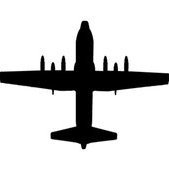
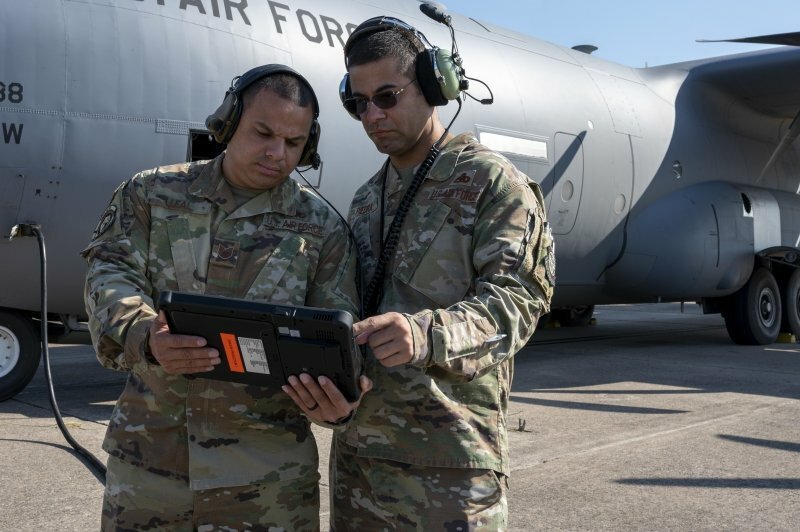
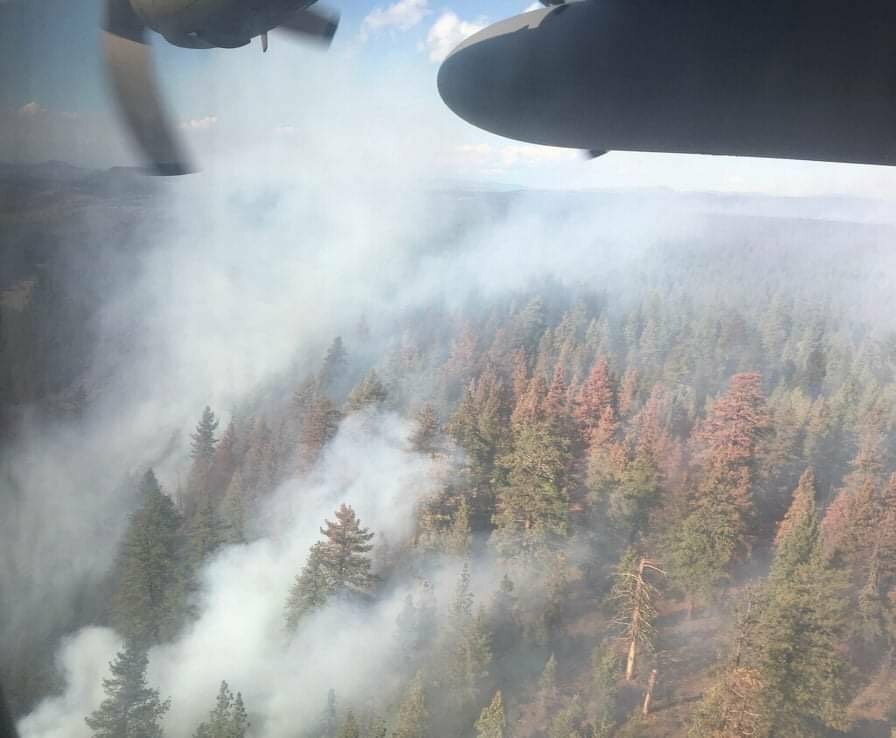
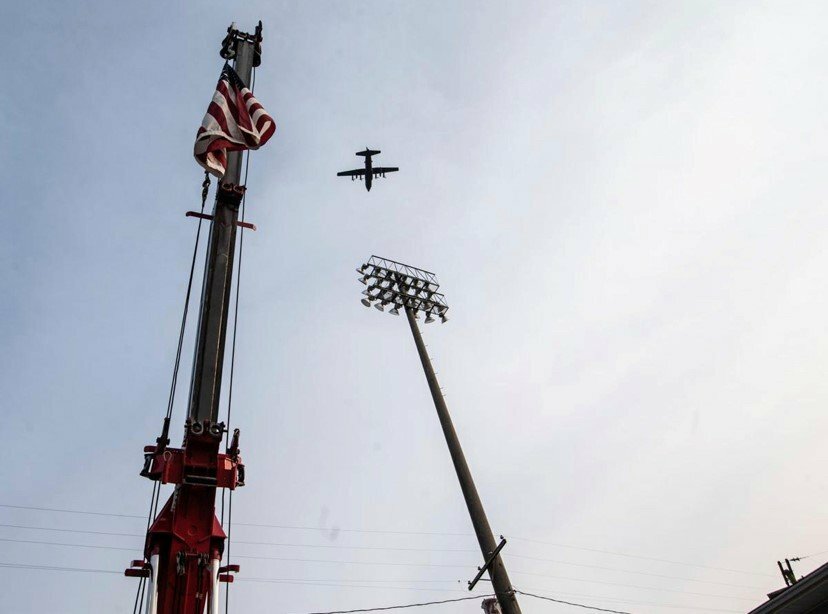
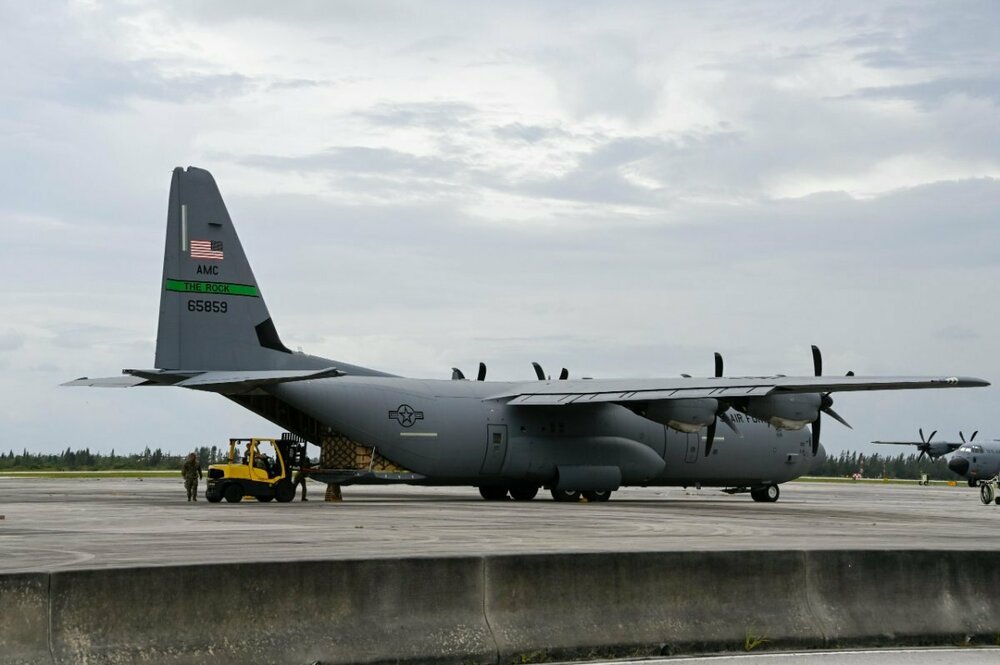
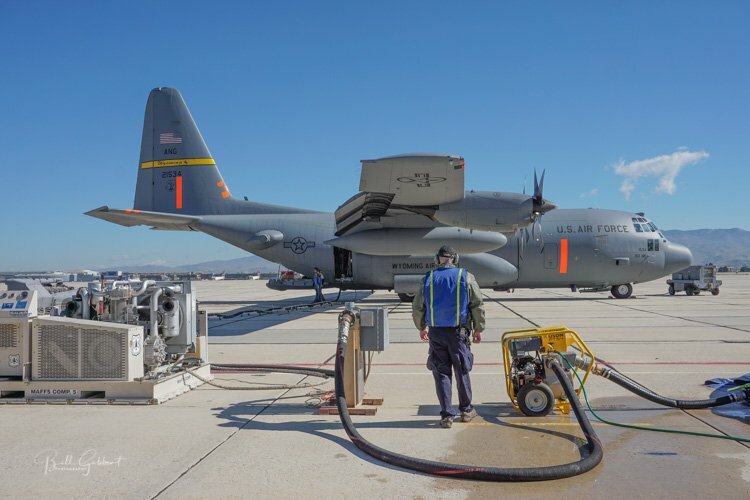
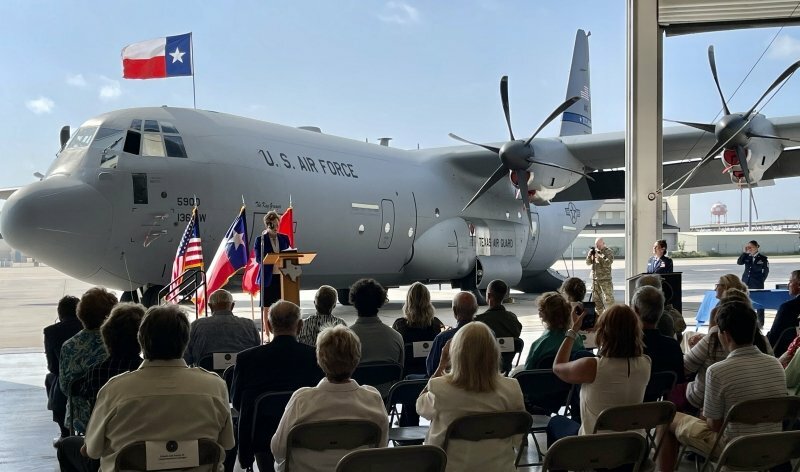
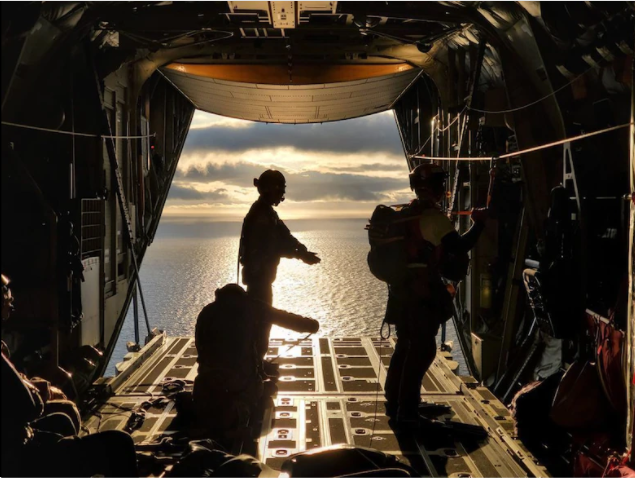
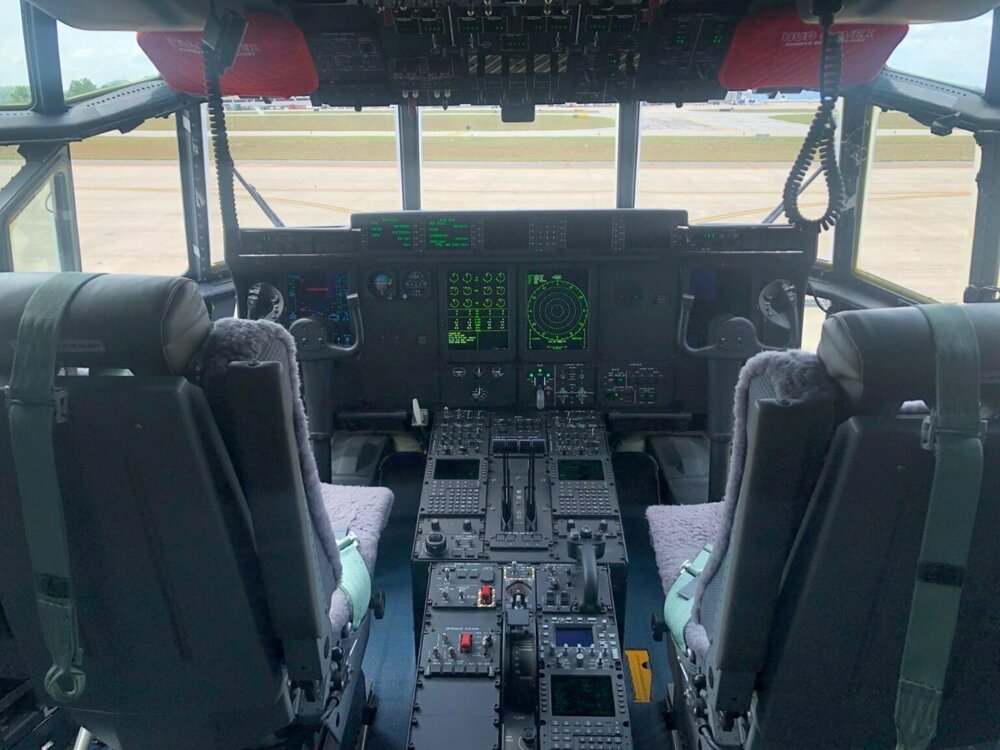
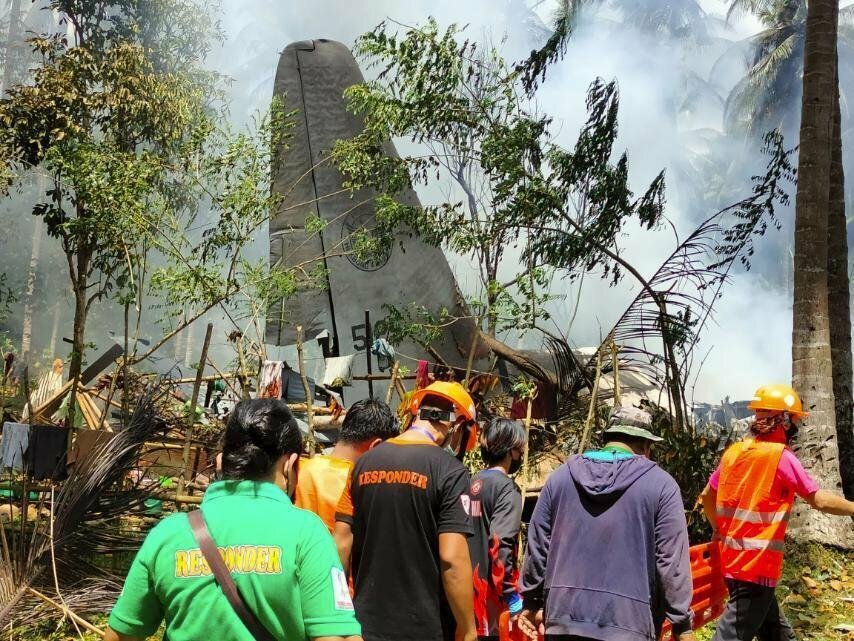
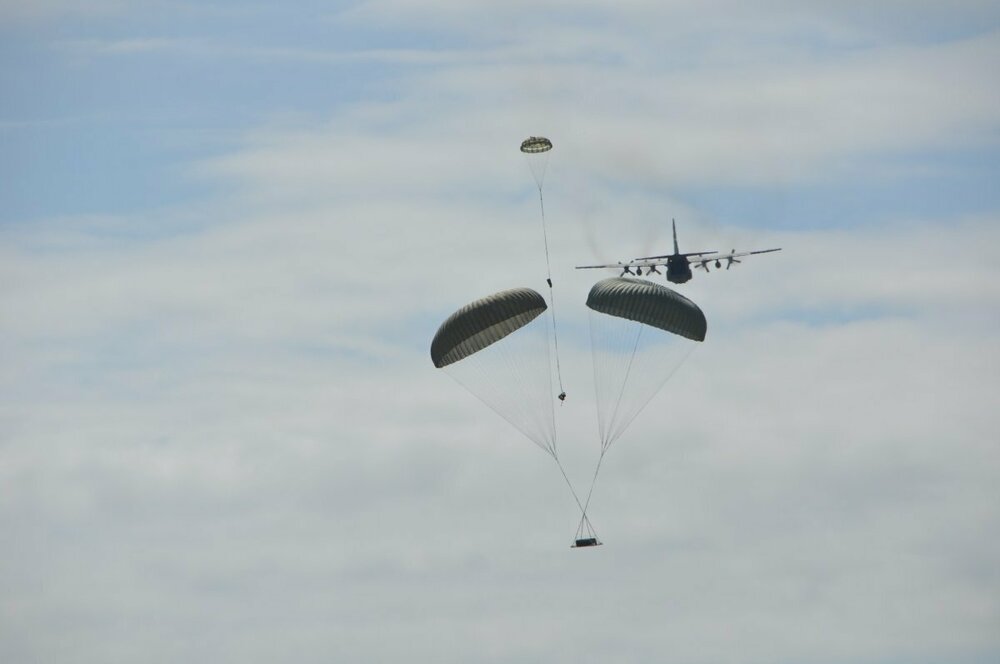
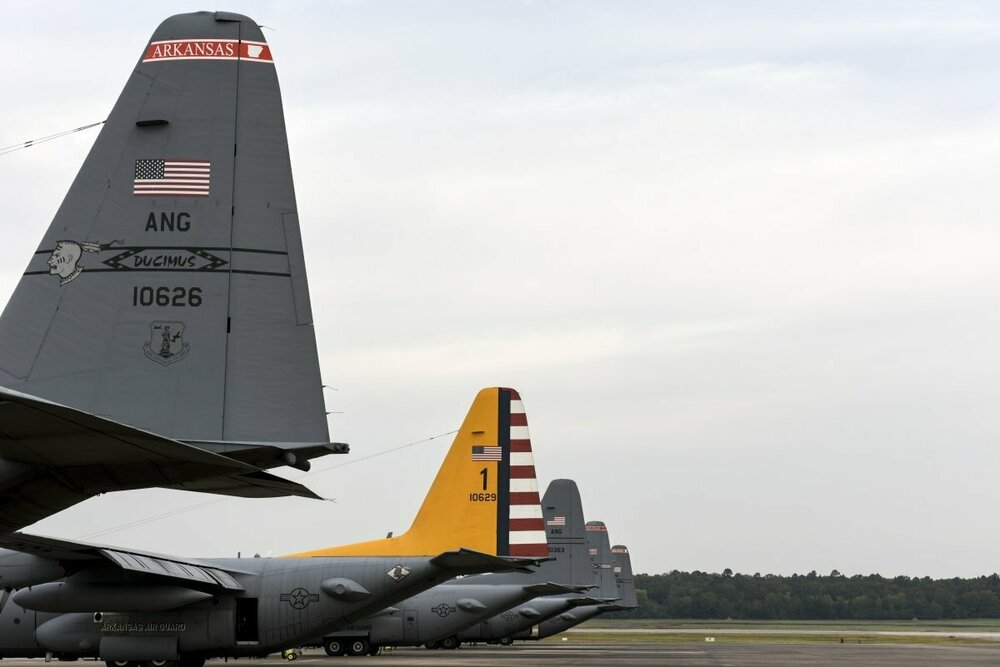
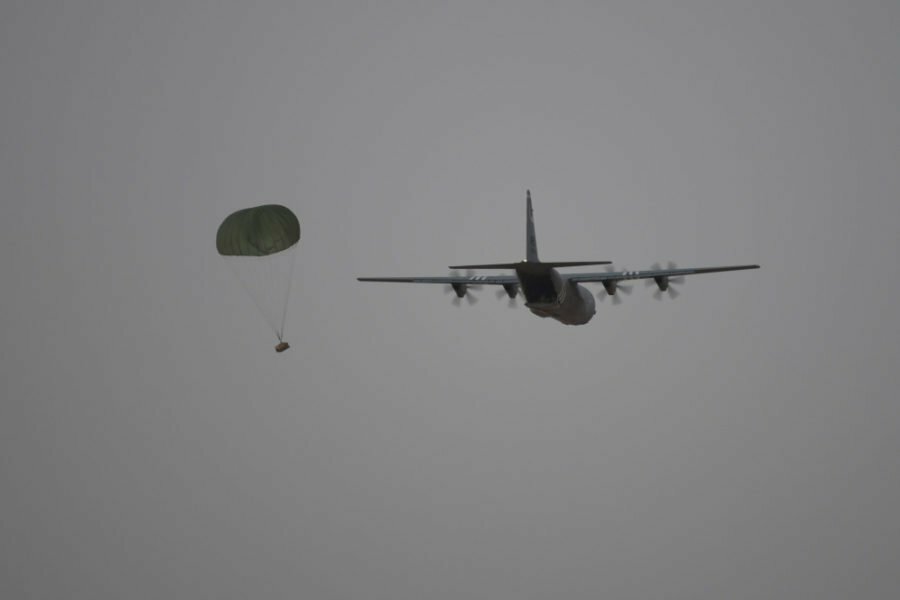




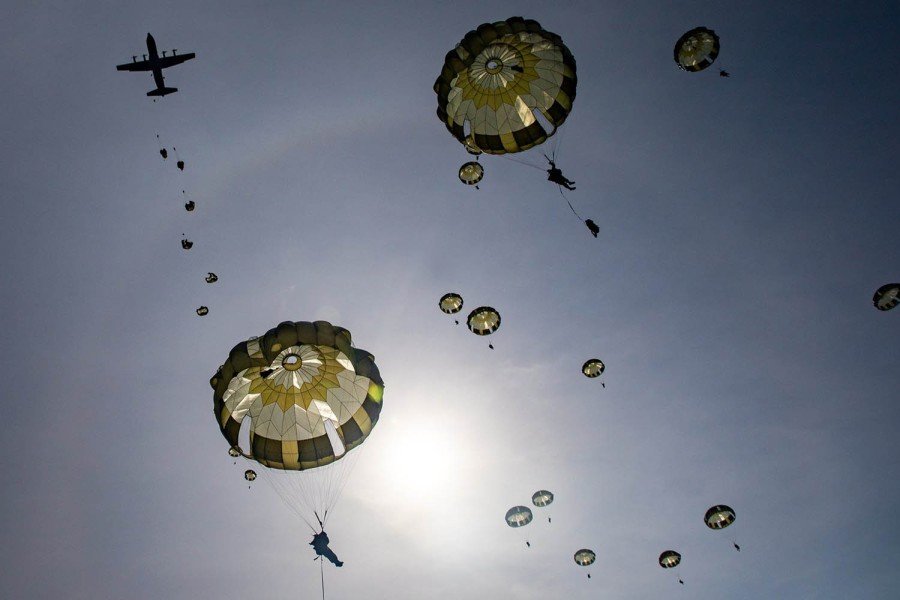



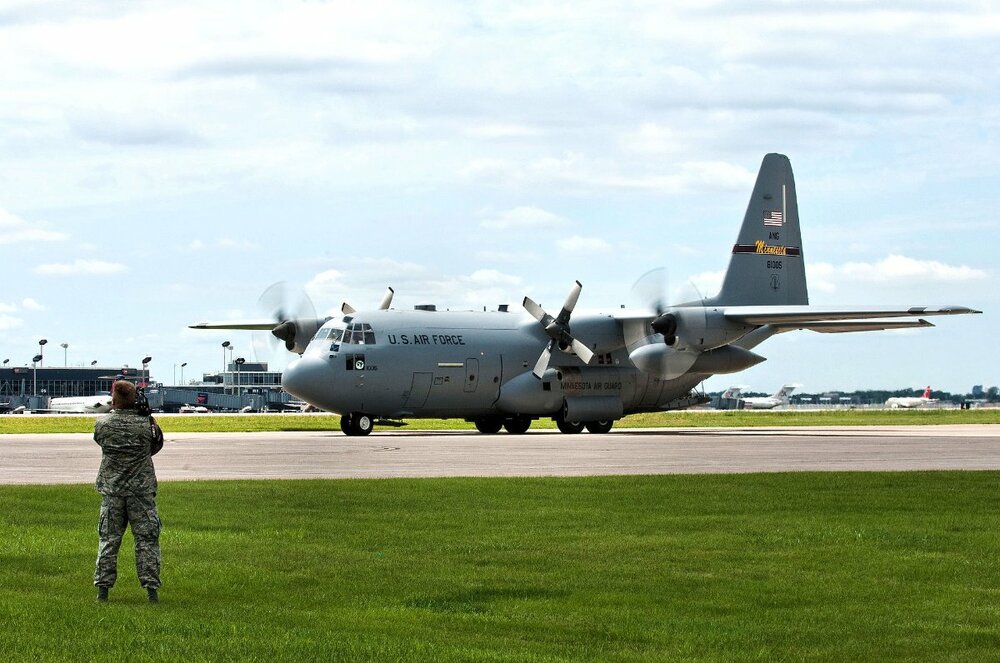

C-130 News: The US Air Force's MC-130 Seaplane is Finally in the Works
in 2021
Posted
Lockheed Martin's C-130J Super Hercules aircraft is not just the workhorse for the military but also a super achiever. In its career that has spanned over two decades, this aircraft has landed in the Arctic, on the highest airstrip, and even an aircraft carrier carrying out medevac, troop, and cargo transport. The US Air Force now plans to make it a seaplane as well, thereby making it possible for this mighty aircraft to land anywhere across the globe.
To ensure that the new version of the aircraft is not just limited to water bodies, the Air Force Special Operations Command is partnering with the Air Force Research Lab's Strategic Development Planning and Experimentation (AFRL-SDPE) to develop amphibious capability. Dubbed as MAC (MC-130J Commando II Amphibious Capability) will "increase placement and access for infiltration, exfiltration, and personnel recovery, as well as providing enhanced logistical capabilities for future competition and conflict," Lt Col Josh Trantham at AFSOC said in the press release.
Colossal Antarctic Cruiser Vanished in the Snow. Here's What Happened to It
The AFSOC is currently working with a task force of industrial partners and plans to undertake a five-phase rapid prototyping schedule to demonstrate operational capability in just 17 months. This could also potentially be used on other C130s with minor modifications, the press release said.
Aiding the accelerated development plans is the Digital Proving Ground (DPG), a virtual setting that uses digital design, virtual reality (VR) modeling, and computer-aided design for simulation and testing of prototypes. The DPG also allows the use of advanced manufacturing for rapid prototyping, further accelerating the testing phase of the prototypes.
The AFSOC released some prototype images that have been tested on the DPG.
According to the press release, the DPG has multiple capabilities such as "mission review, aircraft system analysis, design ideation, engineering risk-reduction, virtual reality, concept imagery" and also allows for feasibility studies. Praising the platform, Maj Kristen Cepak, Chief of Technology Transition Branch at AFSOC said, "Being able to experiment with existing technology to evaluate design tradeoffs and test a new system before ever bending metal is a game-changer."
A rendering of an amphibious modification to an MC-130J Commando II is shown here that is used in the Digital Proving Grounds. Air Force Special Operations Command and private sector counterparts are currently developing a Removable Amphibious Float Modification (RAFM) for the MC-130J, allowing the aircraft to take off and land in bodies of water. (Courtesy photo)
Source: US Air Force
Once developed, MAC is expected to be used by a wide variety of services across the C130 platform, further expanding the versatility of this aircraft and reducing the dependence on dedicated infrastructure such as airstrips that are potential targets during a conflict.
View original article: The US Air Force's MC-130 Seaplane is Finally in the Works (interestingengineering.com)
View full article